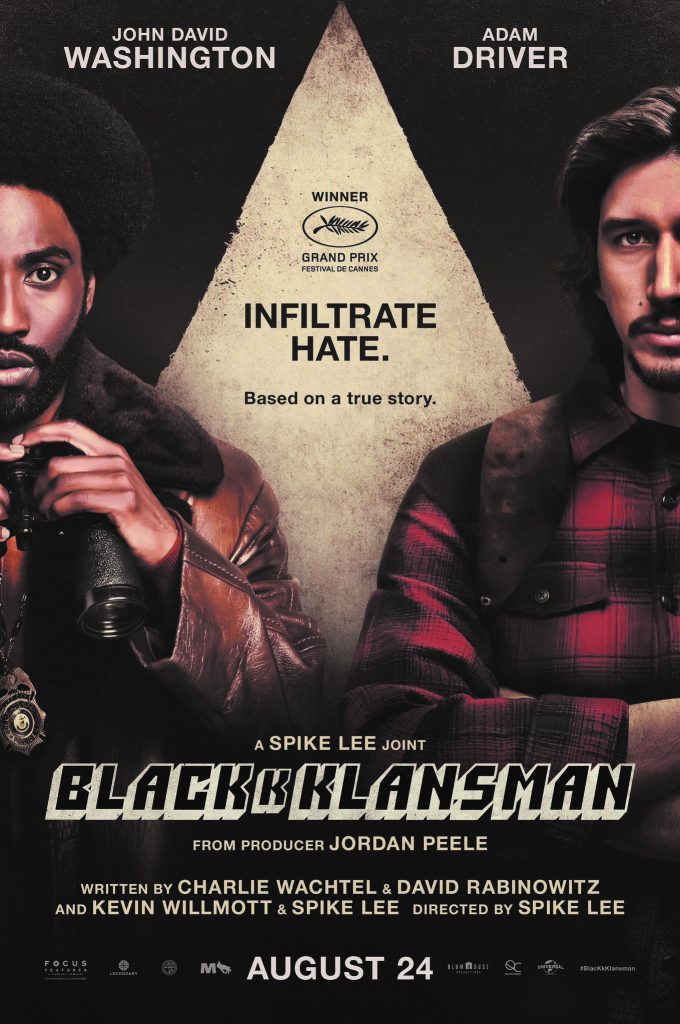
In stride with the increasing number of politically conscious movies that have been released since the 2016 election season, Spike Lee’s new film, “BlacKkKlansman,” produced by Jordan Peele, addresses the distinct differences between the black and white experience in America — both past and present. Furthermore, “BlacKkKansman” is based on a true story, adding an extra layer of validity to the message of racism and police brutality in America that the film builds its characters and plot around. The movie’s tactful summer release date, Aug. 10, coincided with the one-year anniversary of the “Unite the Right” rally that took place in Charlottesville, Virginia on Aug. 11 and Aug. 12, 2017. Not only is this film timely, relevant and culturally provocative, it is disarmingly hilarious, boasts a top-tier cast and has that classic Lee artistic flare.
The film opens on the set of “Gone with the Wind,” showing wounded soldiers during the American Civil War, cutting to Dr. Kennebrew Beauregard, played by Alec Baldwin. Dr. Beauregard goes on to describe to viewers the “scientific” explanation for white racial superiority. As a fan of “Saturday Night Live,” I was pleasantly surprised to see Baldwin take the screen. Though a short introductory scene, it sets the stage for the entire movie, defines the kinds of Americans the movie highlights and addresses historical racism through the eyes of Dr. Beauregard and through the mouthpiece of an actor who’s widely known for his depiction of President Donald Trump on “Saturday Night Live.”
Set in early 1970’s Colorado Springs, the film follows Ron Stallworth — played by John David Washington — a young, black man, and the only black officer at his precinct. After a painstaking stint in the Records Room pulling files, Ron gets his chance to transfer to intelligence where he goes undercover, attending a Colorado College Black Student Union (BSU) event under the premise from his boss that the BSU might be a threat to the community. At the event, he befriends the BSU’s president, Patrice Dumas, played by Laura Harrier. After being enlightened to the united front of young, black students speaking out against racism and calling for justice, Ron begins his first case: infiltrating the local chapter of the Ku Klux Klan.
The parallels to our current political realities are striking and loaded — the protests, the speeches, police brutality, identity. On a more granular level, each character grapples with the realities of prejudice and personal identity. At a time when racially driven police brutality makes headlines, for Ron, being a police officer while simultaneously being black means struggling to do his job without turning a blind eye to the plight of the black community and the police’s historical contribution to it. My favorite part about this movie was the vivid scenes depicting the life and culture of the BSU against the KKK’s ritualistic practices. The striking cinematic juxtaposition between the two, black and white, made the differences blatantly obvious, allowing viewers to look for ways the groups were similar rather than different.
Starting with a phone call, Ron gets a meeting with “The Organization,” but, for obvious reasons, cannot show up to the meeting. Flip Zimmerman, played by Adam Driver, goes in his place, acting as Ron in person while Ron himself continues to communicate via phone with the local chapter of the Ku Klux Klan. Ron eventually develops a telephonic relationship with the Grand Wizard-turned-National Director of the Ku Klux Klan, David Duke, opening him up to the Grand Wizard’s desire for political power outside of The Organization.
After seeing this film, it’s difficult to imagine anyone but Washington delivering the one-liners over the phone to David Duke about his love of “true white Americans.” Washington’s ability to retain the core message of his character’s struggle with identity while riffing with Driver, a seasoned on-screen actor, was a pleasure to watch. “BlacKkKlansman” was a perfect role for Washington’s breakout, and I’m looking forward to seeing other movies in which he can display his versatility and natural presence on screen.
Lee does a masterful job of creating characters with both depth and levity that grapple with identity and race in just over two hours’ time. This brazen film is loaded with quips, hilarious missteps, precise cinematic sequences and ridiculous visuals of racism and distinct juxtaposition between the black and white communities in Colorado Springs through Ron and Flip’s eyes — a must-see. 5/5


